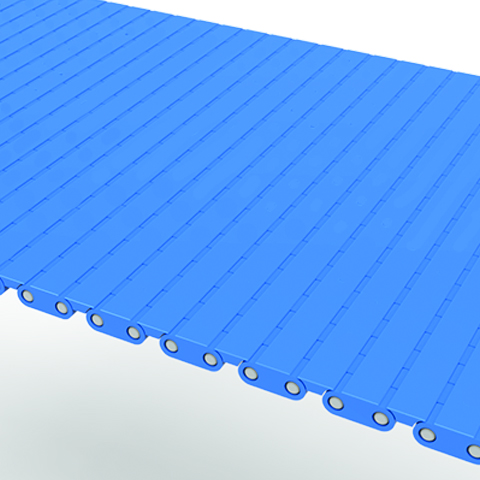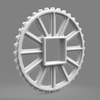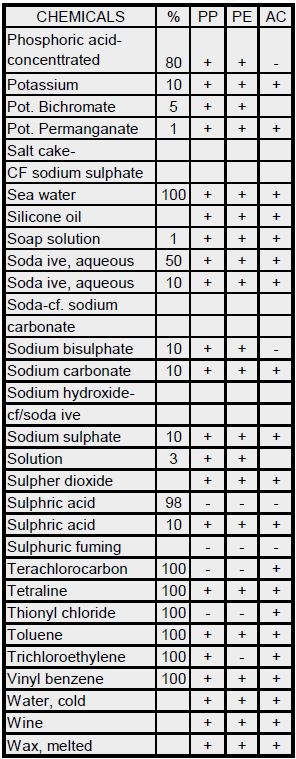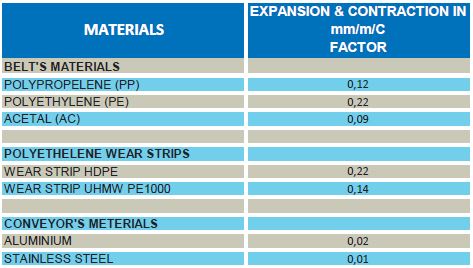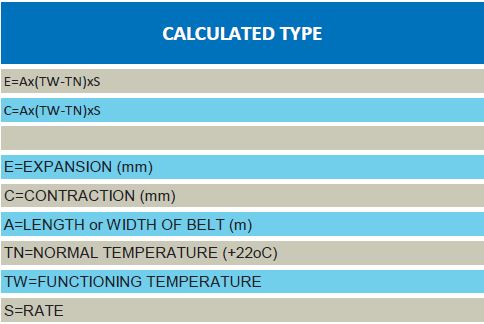ALPHAbelt S2113 - Flat Top
SKU:
Type: Flat Top
Pitch: 12,7mm.
Belt Surface: Flat and Shinny
Segment thickness: 8,4mm.
Connecting Rod: Ø4,5mm.
Approved: EU
Plastic Modular Conveyor Belt ALPHAbelt S.2113 straight.
The surface which contacts the conveyed product is totally closed, flat, and shinny.
The sprockets ALPHAbelt S.2113 can move the belt bidirectionally (drawing 1).
The belt can function without sprockets on the pivot. Instead of using a rotation shaft, it is possible to install a roller Φ6 mm. min (drawing 2).
In the two above-mentioned ways, the distance between two conveyors is minimized and enables the transition from one conveyor to another of very sensitive products (pasta, very small volume products, etc.) without using bridges or other transition means.
On the motion shaft, the appropriate installation of sprockets ALPHAbelt S.2113 is obligatory.
The reversal capability of the belt to the contacting surface with the conveyed product is R30 mm. minimum (drawing 3).
.
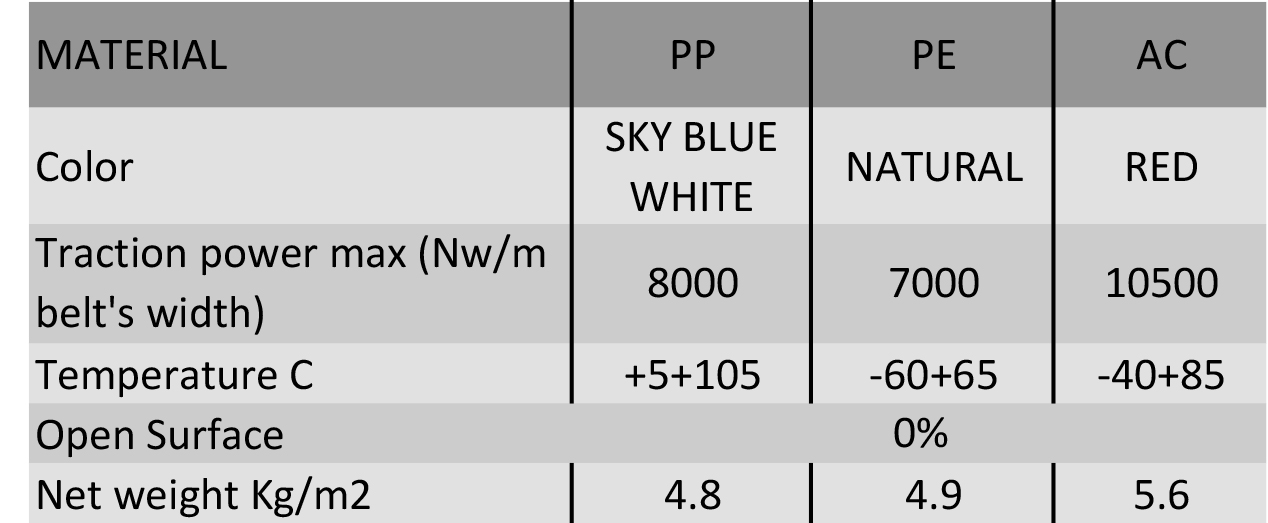
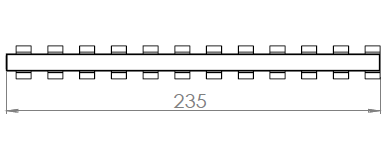
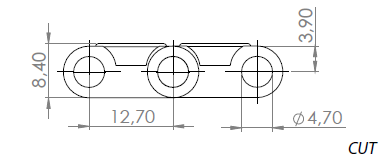
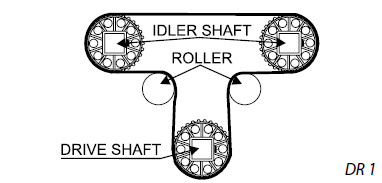
PDF FILE: SPROCKET QUANTITY TABLE
Installation-Maintenance Instructions:
The installation procedure of the conveyor belts ALPHAbelt 2113, 2115, 2400, 2800 και 2900 is simple and fast.
Step 1:
On the driveshaft and the idle shaft put the necessary amount of sprockets ALPHAbelt.
The teeth of all sprockets must be in the same straight line (drawing 1).
The middle sprocket of the drive shaft and the middle sprocket of the idle shaft, must, as well, be in the same straight line(drawing 2).
Lock on the shafts the two middle sprockets(drawing 2).
Step 2:
You receive each belt in one or more roles.
Connect the end of one role with the beginning of the other. NEVER connect the end of the one role with the end of the other or the beginning of the one with the beginning of the other. Insert the connecting rod through the holes of the segments and cut it 1cm shorter than the belts with. By using a thermal device "create ahead"(make the diameter smaller)of the two edge holes of the segments, to prevent any possible extraction of the connecting rod from the segments
Step 3:
Put the conveyor belt on the conveyor and the teeth of the sprockets in the insertions of the belt. Especially for series S2115, put the teeth of sprockets in the insertions of the belt as in drawing 3. The belt which is under the metallic construction (to the return of the belt) is not obligatory to be stretched (drawing 3a) when the idle shaft has sprockets. For S2113 & S2115, when instead of the idle shaft with sprockets, you put a wear strip or a roller, the belt must be stretched by a non-mechanical way (stretching with hands)(drawing 3b).
Step 4:
The belt is ready to function.
Attention: The middle should be in the middle (in relation to the width)of the metallic construction and should not touch any point of it, because this will cause its early damage or even break of the belt.
Give motion to the belt and watch, for a whole turn of the belt, first the sprockets on the driveshaft and then on the idle shaft, to be in the proper insertions of the belt.
If this does not happen, repeat the steps 1 & 3.
When you need to uninstall the belt, just extract one or more plastic connecting rods, to divide the belt into smaller pieces.
The metallic construction on which the belt functions is the main factor that defines its lasting duration. To succeed the longest duration of the belt, place a plastic wear strip between the belt and the metallic construction (drawing 4).
To succeed the maximum capacity of the belt, is useful to put a roller right after the drive shaft (drawing 5), so as the belt to work with more sprocket’s teeth. When the belt is going to work with an idler shaft with sprockets and in temperature over 50 Celsius degrees, to avoid the contact of the belt with the floor, in case of an expansion, you should put rollers (drawing 3).
The plastic motion sprockets, when installed properly on a square drive shaft, ensure the right motion transmission, without causing side slidings of the belt or jumping off the belt. The right motion transmission through the plastic sprockets eliminates the need to use the belt’s stretchers and side guides
When the sprockets are installed on the shaft and the shaft on the metallic construction, the upper point of the sprocket’s diameter (in relation to the teeth of the sprockets), should be in the same straight line with the upper point of the metallic construction, on which the belt moves (drawing 6).
The motion sprockets can move the belt in both directions, under certain circumstances.
Attention:
Once a year, you should check the condition of the connection rod
If its diameter becomes smaller in percentage 15% and more, it should be replaced, because otherwise, it will cause problems such as a. «Jumping» of the sprockets, b. Disability to extract the connection rod from the belt, c. Early and great damage of the belt, in the points that contact the sprockets, d. Unreasonable break of the belt, e. Early damage of the sprocket’s teeth.
During the function of the belt, a grease to the connection rod (even with water), will give much longer duration.
Maintenance: The yearly check of the connection rods necessary. If you notice that the diameter of the connecting rod has been reduced by 15%, it must be replaced, because it will cause problems in the belt and sprockets.
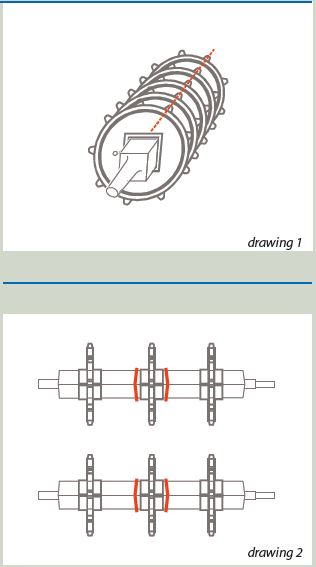
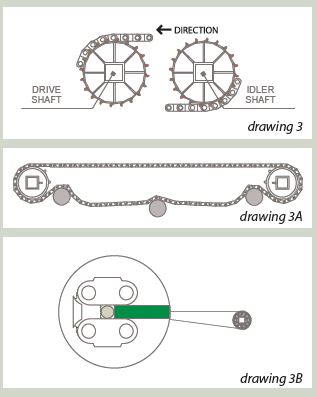
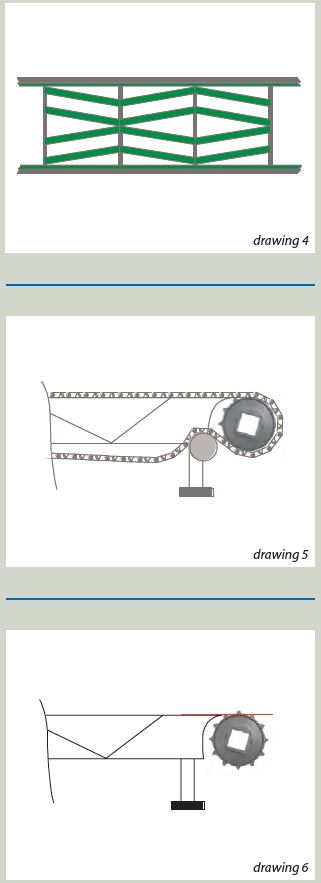
Material specifications
POLYETHYLENE (PE) Thermal plastic with specific gravity approximately 0,92 gr.\cm3.Suitable for use in a cold environment.Temperature range from –73 up to +66 Celcius degrees. High chemical resistance.FDA approved. Stiff but also flexible material with high impact strength
POLYPROPYLENE (PP) Thermal plastic with specific gravity approximately 0,92 gr.\cm3.Suitable for use in higher temperatures.Temperature range from +5 up to +100 Celcius degrees. High chemical resistance.FDA approved. Stiff material with medium intense strength and low impact strength in low temperatures.
PTV Thermal plastic with specific gravity approximately 1.15 gr.\cm3,(self-immersed in water).Suitable for use in high temperatures.Temperature range from +40 up to +130 Celcius degrees Low chemical resistance. Stiff material with medium intense strength and low impact strength in low temperatures.
PGT Thermal plastic with specific gravity approximately 1.16 gr.\cm3,(self-immersed in water).Suitable for use in high temperatures.Temperature range from +50 up to +150 Celcius degrees.Great chemical resistance.
Strong and stiff material. Excellent impact strength, but with high friction between supports and belt.Low impact strength in low temperatures.
POLYPROPYLENE GLASS-FORCED(PPGF) Thermal plastic with specific gravity approximately 1,14 gr.\cm3. Suitable for use in high temperatures.Temperature range from +50 up to +150 Celcius degrees.Great chemical resistance.Strong and stiff material. Excellent impact strength, but with high friction between support and belt.Low impact strength in low temperatures.
POLYPROPYLENE ANTISTATIC (PPAN) Thermal plastic with specific gravity approximately 0,98 gr.\cm3.Suitable for use where static build-up must be dissipated. Temperature range from +5 up to +100 Celcius degrees. Great chemical resistance. The impact strength matches this of plain polypropylene.
POLYPROPYLENE FLAME RETARDANT (PPAF)Thermal plastic with specific gravity approximately 0,98 gr.\cm3.Suitable for use in an environment with high temperature, as microwave ovens etc. Temperature range from +5 up to +120 Celcius degrees.High chemical resistance. Flame resistant VO (3,2 mm.) FDA approved. Stiff material with medium endurance and low impact strength in low temperatures.
ACETAL (AC) Thermal plastic with specific gravity approximately 1,4 gr.\cm3.Suitable for use in high and low temperature.Temperature range from -43 up to +95 Celcius degrees.Low resistance in certain chemicals. FDA approved. Consistent stiff material with high-intensity strength.Low friction between the belt and support.Low impact strength in low temperatures.
ACETAL ANTISTATIC (ACAN) Thermal plastic with specific gravity approximately 1,4 gr.\cm3.Suitable for use where static build-up must be dissipated. Temperature range from -43 up to +95 Celcius degrees. Low resistance in certain chemicals.FDA approved. Consistent stiff material with high-intensity strength.Low friction between the belt and support.Low impact strength in low temperatures.
NYLON 6 (PA6) Thermal plastic with specific gravity approximately 1,08 gr.\cm3.Suitable for use in high and low temperature.Temperature range from -45 up to +110 Celcius degrees. High chemical resistance.Is not suitable for use in an environment with humidity in high temperature.FDA approved. Strong but flexible material, with excellent intense and impart strength.
NYLON 6 GLASS-FORCED (PAGF) Thermal plastic with specific gravity approximately 1,22 gr.\cm3. Suitable for use in high and low temperature.Temperature range from -30 up to +110 Celcius degrees. High chemical resistance.Is not suitable for use in an environment with humidity in high temperature. Strong and unchangeable material, with excellent intense and impact strength.
Chemical Specifications
Material's Resistance In Chemicals:
The values in the following charts are indicative. Factors like the materials filling, temperature, concentration and elasticity can alter the following values significantly. Thus, no guarantee can be given for the correctness of the mentioned values. These values are valid in temperature 20Celsius degrees.
Symbols Explanation:
+Resistance No change or very slight change in weight (<0.5%). No change in mechanical characteristics.
+/-Duration in time After some time significant changes in weight, mass,(0.5-5) Possible strength and flexibility reduce. Extensive use only in simple uses of materials.
- Unsuitable Significant and fast denaturation in weight, mass(>5%), significant denaturation in strength and flexibility. Not advisable to use.
%Consentration If value is given is because no test resalt from materials suppliers is available.
Calculate Correctly:
All the objects (plastic or metallic) change their dimensions, according to the environment temperature fin which they function.
To calculate the dimensions of a belt and the metallic construction of a conveyor, the following should be calculated.
.
Calculation example of the expansion of a conveyor belt, made of Polypropelene, with dimensions 10m (10.000mm) lengthand 1,1m (1.100mm) width, which functions in an environment with temperature +90C
LENGTH
E= 10 χ [(+90)-(+22)] χ 0,12
Ε=81,6mm
WIDTH
E= 1,1 χ [(+90)-(+22)] χ 0,12
Ε=9mm
Calculation example of the contraction of a conveyor belt, made of Polyethelene, with dimensions 10m (10.000mm) length and 1,1m (1.100mm) width, which functions in an environment with temperature -60C.
LENGTH
C= 10 χ [(-60) - (+22)] χ 0,12
C=98,4mm
WIDTH
C=1,1 χ [(-60) - (+22)] χ 0,12
C=11mm
PDF FILE: Inquiry Form



